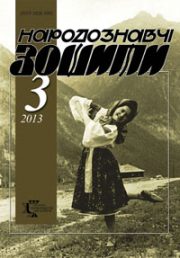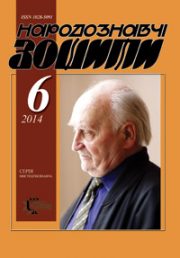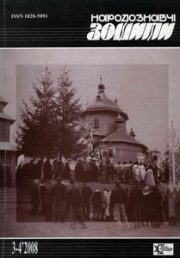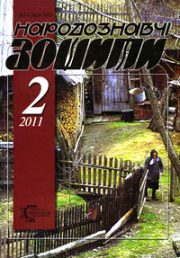The Ethnology Notebooks. 2024. № 4 (178), 752—768
UDK [39(=161.2):929](477.83-22Волосянка):930.2
DOI https://doi.org/10.15407/nz2024.04.752
BOYKO VILLAGE IN THE FOCUS OF PROMINENT FIGURES
SOKIL Vasyl
- ORCID ID: https://orcid.org/0000-0003-3164-1217
- Doctor of Philological Sciences [Dr. Hab], Professor,
- Head of the Folklore Department,
- Institute of the NAS of Ukraine,
- 15, Svobody Avenue, 79000, Lviv, Ukraine,
- Contacts: e-mail: vasylsokil@gmail.com
Abstract. The article is about Volosianka, the Boyko village located in the Skole district. For over a century and a half, it had been attracting the attention of many remarkable people such as priests, writers, artists, teachers, lawyers, and others. The visits were most often associated with the Rewakovychs, a respected family of the local priest. They were known for their strong national consciousness, firm moral and ethical principles, and had great respect among the locals. Some prominent people had a direct connection to the village, performing functional duties (Mykola Ustyianovych), while others were living there for some time (Kornylo Ustyianovych, Fedir Zarevych), someone was invited for recreation (Oleksandr Konyskyi), and others were receiving assistance in implementing their election programs (Yevhen Olesnytsky). Some had scientific ambitions, recording materials for their works (Ivan Verkhratskyi, Zenon Kuzelia). There were also those who were developing the Ukrainian school (Dmytro Romanets). The local folklore collection, which was recorded and passed on to descendants by Hryhorii Demian, turned out to be unique.
The aim of this publication is to find out the role and significance of the visits of important figures in the historical and cultural development of the village. Particular attention is paid to personal contacts, their assessments, valuable folklore and ethnographic materials, memoirs, artistic works, etc.
The object of study is the little-known heritage of the lives and activities of these personalities, who contributed to enriching history with interesting facts. This is the relevance of the topic as well. Various source materials were used for the research.
Historical, analytical-theoretical, and biographical research methods were applied.
Keywords: boyko village, historical-cultural research, prominent figures, biography, science, epistolary.
Received 27.06.2024
REFERENCES
- Franko, I. (1980). Nikolay Ustiyanovych. [Obituary]. In: Ivan Franko. Collected works: in the 50s. (Vol. 26, pp. 380—383). Kyiv: Naukova dumka [in Ukrainian].
- Sokil, V. (2019). Epistolary of Tito Revakovich. Lviv [in Ukrainian].
- Franko, I. (1976). Men’s Jokes. A poem from the last times of the lordship. In: Ivan Franko. Zibr. works in the 1950s. (Vol. 2, pp. 7—9). Kyiv: Naukova dumka [in Ukrainian].
- Revakovich, T. (1911, December 7). Memoirs of Nikola Ustiyanovich (born poet in the 5th century. *December 7, 1811, +3 padolyst 1885). Work. Lviv [in Ukrainian].
- Bazhan, M.P., & Afanasyev, V.A. (Eds.). (1973). Ustiyanovych Kornylo Mykolayovych. Dictionary of artists of Ukraine. Kyiv: URE [in Ukrainian].
- Nanovskyi,Ya. (1963). Kornylo Mykolayovych Ustiyanovych. Kyiv: Mystetstvo [in Ukrainian].
- Holod, I.V. (2013). Ustiyanovych Kornylo Mykolayovych. Ukrainian fine art: names, biographies, works (XI—XXI centuries) (Pp. 220—223). Kharkiv: Fakt [in Ukrainian].
- Ustiyanovych, K. (1891, February 27 (March 11). Something about painting churches. Work (Part 47) [in Ukrainian].
- Fedoruk, O. (1992). Kornylo Ustyyanovych. Story. Kyiv: Veselka [in Ukrainian].
- Revakovich, T. (1917). Memories of Kornyl Ustiyanovich. World (Pp. 90—93) [in Ukrainian].
- Franko, I. (1984). Essay on the history of Ukrainian-Russian literature until 1890. In: Ivan Franko. Collected works: in the 1950s. (Vol. 41, pp. 194—470). Kyiv: Naukova dumka [in Ukrainian].
- Demyan, G. (1991). Talents of Boykivshchyna. Lviv: Kamenyar [in Ukrainian].
- Revakovich, T. (1882). Memories of Fyodor Zarevych. Truth (Vol. 2, issue 4, p. 286) [in Ukrainian].
- (1889). Letter of F. Zarevych to T. Revakovich dated 27.XI.1873. True (Vol. 2, issue 4, p. 296) [in Ukrainian].
- Olesnytskyi, E. (1935). Pages from my life (Part II). Lviv [in Ukrainian].
- Franko, I. (1982). Ethnographic expedition to Boykivshchyna. In: Ivan Franko. Collected works in the 1950s. (Vol. 36, pp. 68—99). Kyiv: Naukova dumka [in Ukrainian].
- Kuzela, Z. (1914—1915). Sitting and having fun with the dead in the Ukrainian funeral rite. Notes of NTSH (Vol. 121, pp. 173—224; vol. 122, pp. 103—160). Lviv [in Ukrainian].
- Extract from the service and qualification list. Central State Historical Archive in Lviv. F. 179. Op. 7. Unit coll. 22030. Ark. 5—6 p. [in Ukrainian].
- To the school district board in Stry. Wolosianka, on October 20. 1938. (Statement of D. Romanets about participation in the competition for the head of the school). Central State Historical Archive in Lviv. F. 179. Op. 7. Unit coll. 22030. Ark. 4 [in Ukrainian].
- To the Board of the Lviv School District. Wolosianka — competitive selection for the position of school principal. On May 2, 1939. Central State Historical Archive in Lviv. F. 179. Op. 7. Unit coll. 22030. Ark. 1 [in Ukrainian].
- To Mr. School Inspector in Skolim. 1925. (Harassment of the community of Volosanki of the Ukrainian language of learning). Parish archive of Hair [in Ukrainian].
- To the Board of the School District in Lviv. Skole. On June 26, 1925. Wolosianka, one-class school with Russian as the language of instruction, change to bilingualism. Central State Historical Archive in Lviv. F. 179. Op. 2. Unit coll. 511. Ark. 1 [in Ukrainian].
- Notice of the reading room «Prosvita» p. Hair November 9, 1933. Chairman Dmytro Romanets. Central State Historical Archive in Lviv. F. 348. Op. 1. Unit coll. 1645. Ark. 18—19 p. [in Ukrainian].
- Notice of the reading room «Prosvita» p. Hair February 26, 1934. Chairman Dmytro Romanets. Central State Historical Archive in Lviv. F. 348. Op. 1. Unit coll. 1645. Ark. 20—21 [in Ukrainian].
- Notice of the reading room «Prosvita» p. Volosianka December 31, 1934. Chairman Dmytro Vepriv. Annex to the report. Central State Historical Archive in Lviv. F. 348. Op. 1. Unit coll. 1645. Ark. 26 [in Ukrainian].
- Demyan, H.V. (Ed.). Onomatopoeic legends and tales of Boikos and Hutsuls. From the folklore records of H. Demyan [in Ukrainian].
- Demyan, H.V. (Ed.). (1974). Kolomiyki [in Ukrainian].
- Sokil, Vasyl. (2016). Volosyanka in folklore. Lviv [in Ukrainian].
- Demyan, H.V. (Ed.). (1979). Folk songs from Boykivshchyna. Lviv [in Ukrainian].
- Myshanych, S.V. (1981). From the Carpathian Mountains. Ukrainian folk songs-ballads. Uzhhorod: Carpathians [in Ukrainian].
- Sokil, Vasyl. (2009). Folk songs from the voice of Paraska Pavlyuk. Lviv [in Ukrainian].







